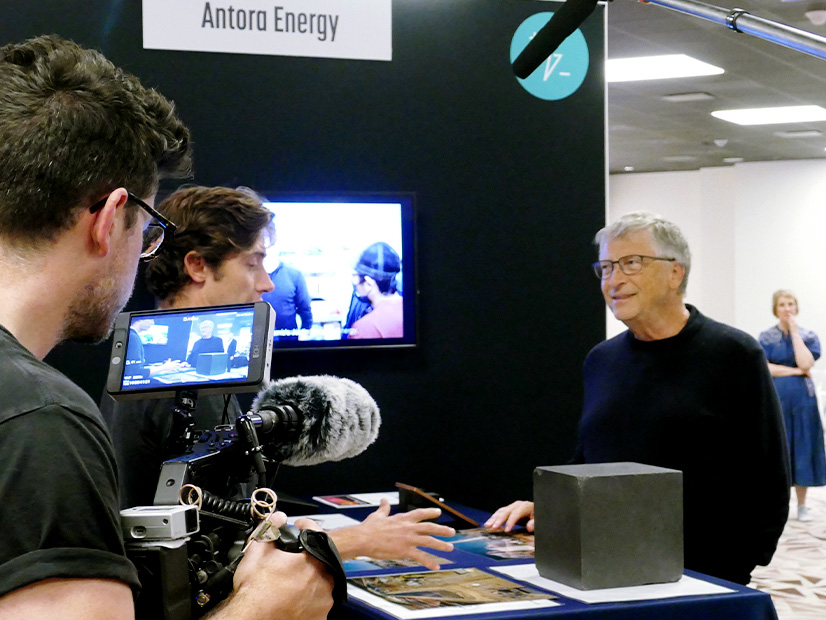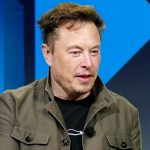AUSTIN, Texas — Two of the world’s richest men, who are using their billions to help the clean energy transition, drew gawkers and rubberneckers in the halls of the JW Marriott Austin hotel’s event space during Edison Electric Institute’s annual conference last month.
Bill Gates and Elon Musk each filled the main ballroom with their respective keynotes. Gates, dapper in a business casual blazer, needed little prodding to share his thoughts on a clean energy future. Musk, wearing a fashionable outfit that included an open zipper across his chest and cowboy boots, was a man of fewer words, but big thoughts.
Gates showed up the day before his appearance. Trailed by a camera crew, he slipped into the conference’s networking center, which doubled as a trade show. It wasn’t long before Gates was surrounded by scores of observers as he made the first of several stops to the booths.
“Hey, Bill Gates is over there,” whispered one EEI staffer to another.
His first stop was at Antora Energy, a startup that uses thermal batteries to store renewable energy in carbon blocks that are then heated to 2,700 degrees Fahrenheit. The energy is discharged as zero-emission heat and/or power.
Antora is just one of more than 110 clean energy technologies that Gates’ Breakthrough Energy has invested in, about a dozen of which set up booths at the conference. The organization, founded by Gates in 2015, is working to accelerate innovation in sustainable energy and other technologies to reduce greenhouse gas emissions and reach a goal of net-zero emissions by 2050.
“Great ideas are just the beginning,” Gates explains on Breakthrough’s website. “We need a plan — and the willingness to do the hard work — so we can get on track over the next decade.”
“The key playbook of Breakthrough Energy has been to drive innovation and to drive policies for innovation,” Gates said from EEI’s main stage. “When we got this thing started in 2015, I didn’t know if we would find the innovative ideas. We raised several billion dollars, and amazingly, mostly here in the United States, we found phenomenal entrepreneurs and scientists together applying [for investment]. And so in any area of emissions, we now see the path to get there with execution, particularly on the green grid, which will be two and a half times the size of what we have today because of massive electrification.
“Massive electrification is daunting, but you can see that there is a path, a path that doesn’t involve saying to people, ‘OK, you now have to pay a lot more money for all your goods, including electricity,’” he said.
Asked by Ameren’s executive chairman, Warner Baxter, why he has such a rosy view that the 2050 net-zero goal will be reached, Gates pointed simply to civilization.
“The modern economy is about energy intensification. Crude oil and natural gas are magical things. The energy density there has allowed us to transform life in this very dramatic way,” Gates said. “The idea that now we have this goal, that by 2050 will basically replace all those cement plants, steel plants, coal plants — there’s no equivalent thing, even if you take the work that was done during World War II.”
He said the multidecade effort will have to be coordinated to make it work. That includes the “incredibly complex” task of designing a new electric grid.
“Many people, when they look at the climate problem, they’re like, ‘OK, what can we do to make a little bit of progress?’ But as you look at it, you’d say, “Oh, no, I need to get all the way to zero,’” he said. “You have to do the very hard things, and you have to do it not just in the rich countries but also in middle-income countries that now account for the bulk of the [world’s] nations. We have a lot of work to do to get to that in a very short period of time.
“We’re no longer able to say, ‘OK, in the near term, it’s business as usual,’ and then that payment comes later. We are now in the time period where the rate of renewable build and the rate of transmission permitting is completely inadequate to this goal. And yet, people have worked with us to lead on this.”
While obviously a fan of renewable energy, Gates said individual states’ incentives for generation and transmission projects will make it difficult to ensure reliability as more renewables are integrated onto the grid.
“If a huge part [of generation] is renewable energy — offshore wind, onshore wind, solar — then you’ll have parts of the United States where they will not be able to generate enough energy,” he said. “And so the idea that this has been done overwhelmingly at the state level — here’s a load; here’s [a] generator that’s fairly near that load — that paradigm does not work to get to zero emissions.”
Musk: Demand to Triple by 2045
Musk focuses much of his energy on electric vehicles, batteries and solar panels. That is, when he’s not exploring space, boring tunnels underground or attempting to manage his social media company.
He rose to fame and riches with Tesla, which dominates the EV market. Its massive Austin Gigafactory —driving past the 2,500-acre facility at the nearby state highway’s speed limit takes about 45 seconds — produces 5,000 Model Ys a week. Globally, more than 440,000 EVs rolled off Tesla production lines during the first quarter of this year.
Just before Musk’s appearance at EEI, Tesla announced it was partnering with Ford and General Motors and sharing charging infrastructure. Electrify America, the country’s largest fast-charging network for other EVs, has said it will incorporate Tesla’s charging standard into its stations as part of its commitment to “broaden charging solutions.”
“I think opening up the chargers is morally right, and it was something that will help power sustainability,” Musk told his audience. “We’re really trying to do everything here. We will support all electric vehicles on equal footing. We’re not advocating for special treatment of Tesla. We’re trying to clear a path for sustainability.”
However, Musk said, if the U.S. is to achieve a sustainable future, his back-of-the-envelope projections indicate electricity demand will triple by 2045.
“Everything is going to be electric,” he told his EEI audience. “I don’t know what your plans are for future electricity demand, but it’s going to be much higher than you think. You should start to plan now. We’re trying to work to a sustainable energy future, and it’s going to take many technology solutions to get there.
“I think this is good news for everyone who produces electricity, but it entails a tremendous amount of work ahead,” Musk added.
The key is the three pillars of a sustainable energy future, he said. They are sustainable power generation like solar, wind, hydro and nuclear; stationary batteries; and electric transportation.
“Once we have those three pillars in place, we’ll have a sustainable future for as long as the sun shines and the wind blows,” Musk said. “It will very much be a joint effort. The utilities have the wires; they’re the distributors of electricity. It’s hard work to actually put that generation in place and transport it to where it gets used, but we have to take advantage of the valleys of power production.”
Of course, he pushed Tesla Energy’s Powerwall as part of the equation. The sleek rechargeable lithium-ion residential battery stores solar energy for self-consumption, time-of-use load shifting and backup power. Aggregated together, they can be even more beneficial to the grid, Musk said.
“You’re operating collectively and helping to stabilize and preserve everything. The Powerwall battery pack is a helpful part of solving the energy problem because there’s a lot of neighborhoods where it’s hard to get incremental power to that neighborhood because you need more substations and you need more wires. Local storage helps alleviate some very boring situations where it’s just so frustratingly difficult to get more power to that neighborhood. It’s really a big deal and really helpful because obviously, it’s battery at scale, and it pumps electricity. We can do electricity better.”


